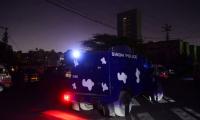Islamabad : South Asian Strategic Stability Institute (SASSI) University held an international webinar on ‘Inside threats to nuclear facilities’ here to discuss safety and security threats to nuclear installations, offices and materials that may be posed by employees and staff working in nuclear facilities.
Speakers from International Atomic Energy Agency (IAEA), World Institute of Nuclear Security (WINS) and academicians, experts, SASSI Alumnae, and students attended discussions at the SASSI office and also online. Prof Zafar Nawaz Jaspal, Quaid-i-Azam University, conducted the proceedings.
Dr Robert K Larsen, Senior Nuclear Security Officer, Nuclear Security of Materials and Facilities (MAFA), IAEA, Vienna, Austria, citing documents and publications said that employees must be subjected to pre-and post-employment testing to determine the psychological and behavioural personality of applicants including any excessive indulgence in drugs or alcoholism. The individuals having access to nuclear material and facilities should be monitored in particular. He also referred to “unwilling insiders” who may also be a threat. He said that an insider could create disruption and if fire alarm, he could get out using the normal procedure. Disruption in records and databases could also be made.
He said that sabotage is any deliberate act exposing staff to radiation. He said that 200m euros were spent at 9 nuclear sites but no radioactivity was involved. He cited some examples of thefts.
Suggesting measures, he said that we should try to reduce potential insiders, minimise opportunities by preventive measures in addition to protective measures. He said we can delay, respond, mitigate and minimise consequences. The issue should be handled holistically. Timely detection of malicious actions is important and there should be responsible before the material goes out of boundary. He said that daily administrative checks, verification, etc. are also necessary.
The IAEA official said that salary should be modest and the staff should be given respect to what they perform. The facility should also be compartmentalised, he said. Security awareness, periodical assessment of security programmes, marriages, divorce number of children should be noted. Reassessment of trustworthiness programmes is very necessary. He invited member countries to attend training courses on insider threats at IAEA.
Pierre Legoux, Head, Implementation, World Implementation, WINS, Vienna, said that inside threats are always reported in all sensitive and high-value industries. Assessing the design-based threat (DBT) is a serious and formal activity. An insider could be passive or active, non-violent or violent, rational or irrational. The motivations, intentions, and capabilities of any suspect should be monitored. He said that motivation could be ideological, financial, out of revenge, ego, psychotic, or coercion while intentions could be theft, sabotage, or terror. He advised not to rely on single protection measures.
He emphasised that staff is an asset and not a threat. Involve all staff and departments, designate a leading staff for security and take action if reports of non-compliance, he concluded.
Speaking on the occasion, the Director, Nuclear Security Programme, SASSI, observed that Insider Threat is one of the greatest threats humanity is facing. Nuclear security regimes in Pakistan evolved over the years with IAEA help correspond to international standards while Pakistan Nuclear Regulatory Authority on its understanding takes steps for protection and prevention of insider threats.
Dr Maria Sultan, Director-General, SASSI University, said that individuals with malicious intentions pose a serious threat to the safety and security of nuclear installations as they can easily bypass multiple layers of safeguards and security. She paid gratitude to IAEA, WINS, and QAU for joining this interesting and informative webinar. Insider threats are credible but can be mitigated and the role of licensing authorities and international agencies becomes crucial in this respect.
A representational image shows a person holding a cigarette between the fingers. — AFP/FileIslamabad:An increase of...
Pakistan National Council of the Arts building can be seen in this image. — Radio Pakistan/FileIslamabad:The...
Officials pose for a photo during a visit to Islamabad Traffic Police Office on May 6, 2024. — Facebook/Islamabad...
Federal Minister for Communications, Privatisation & Investment Board Abdul Aleem Khan 9C) inspects the damage caused...
Chairman of the Capital Development Authority Chaudhry Muhammad Ali Randhawa chairs a meeting on May 6, 2024. —...
A representational image of a person examining an Xray. — Unsplash/FileRawalpindi: Providing public health...







